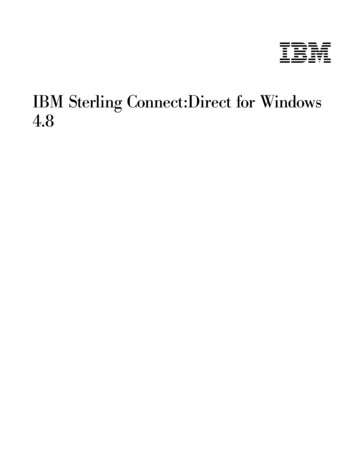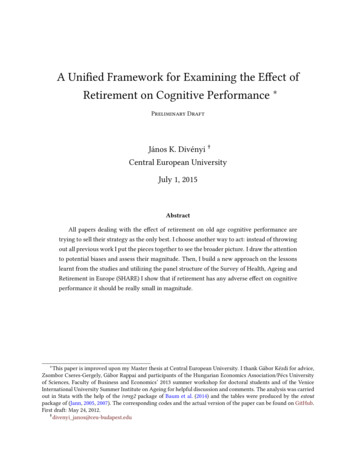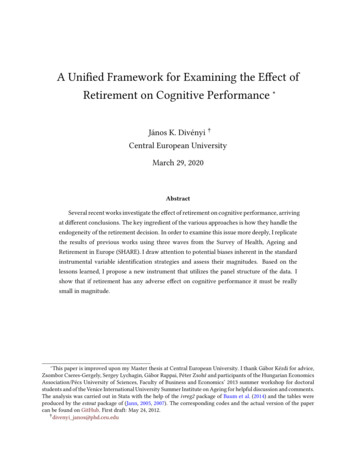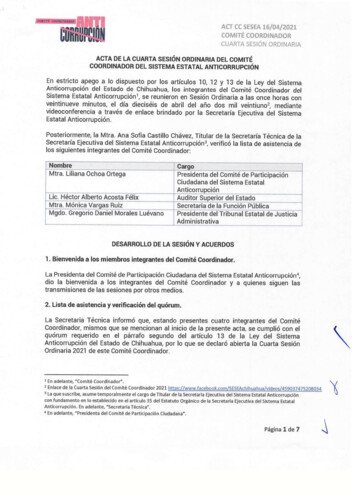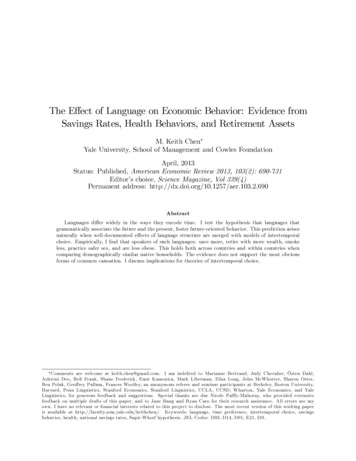
Transcription
The E ect of Language on Economic Behavior: Evidence fromSavings Rates, Health Behaviors, and Retirement AssetsM. Keith ChenYale University, School of Management and Cowles FoundationApril, 2013Status: Published, American Economic Review 2013, 103(2): 690-731Editor’s choice, Science Magazine, Vol 339(4)Permanent address: guages di er widely in the ways they encode time. I test the hypothesis that languages thatgrammatically associate the future and the present, foster future-oriented behavior. This prediction arisesnaturally when well-documented e ects of language structure are merged with models of intertemporalchoice. Empirically, I nd that speakers of such languages: save more, retire with more wealth, smokeless, practice safer sex, and are less obese. This holds both across countries and within countries whencomparing demographically similar native households. The evidence does not support the most obviousforms of common causation. I discuss implications for theories of intertemporal choice.Comments are welcome at keith.chen@gmail.com. I am indebted to Marianne Bertrand, Judy Chevalier, Östen Dahl,Ashwini Deo, Bob Frank, Shane Frederick, Emir Kamenica, Mark Liberman, Elisa Long, John McWhorter, Sharon Oster,Ben Polak, Geo rey Pullum, Frances Woolley, an anonymous referee and seminar participants at Berkeley, Boston University,Harvard, Penn Linguistics, Stanford Economics, Stanford Linguistics, UCLA, UCSD, Wharton, Yale Economics, and YaleLinguistics, for generous feedback and suggestions. Special thanks are due Nicole Pal y-Muhoray, who provided extensivefeedback on multiple drafts of this paper, and to Jane Bang and Ryan Caro for their research assistance. All errors are myown. I have no relevant or nancial interests related to this project to disclose. The most recent version of this working paperis available at http://faculty.som.yale.edu/keithchen/. Keywords: language, time preference, intertemporal choice, savingsbehavior, health, national savings rates, Sapir-Whorf hypothesis. JEL Codes: D03, D14, D91, E21, I10.
1IntroductionLanguages differ in whether or not they require speakers to grammatically mark future events.For example, a German speaker predicting rain can naturally do so in the present tense, saying:Morgen regnet es which translates to ‘It rains tomorrow’. In contrast, English would require theuse of a future marker like ‘will’ or ‘is going to’, as in: ‘It will rain tomorrow’.1 In this way, Englishrequires speakers to encode a distinction between present and future events, while German doesnot.2 Could this characteristic of language influence speakers’ intertemporal choices?In this paper I test a linguistic-savings hypothesis: that being required to speak in a distinctway about future events leads speakers to take fewer future-oriented actions. This hypothesis arisesnaturally if grammatically separating the future and the present leads speakers to disassociate thefuture from the present. This would make the future feel more distant, and since saving involvescurrent costs for future rewards, would make saving harder. On the other hand, some languagesgrammatically equate the present and future. Those speakers would be more willing to save for afuture which appears closer. Put another way, I ask whether a habit of speech which disassociatesthe future from the present, can cause people to devalue future rewards.The bulk of this paper investigates whether this prediction is borne out in savings behavior.To do so, I first review the literature on what linguists call future-time reference (FTR), whichstudies both when and how languages require speakers to mark the timing of events. From thisliterature I adopt a future-time criterion from typological linguistics, which separates languages intotwo broad categories: weak and strong FTR. This criterion separates those languages that requirefuture events to be grammatically marked when making predictions (strong-FTR languages, likeEnglish), from those that do not (weak-FTR languages, like German).3 By analyzing text samplesextracted from the web, I confirm that this linguistic distinction captures a central tendency ofhow languages mark future events, and that this distinction can be both generated and verified inautomatically collected data.I then examine how these linguistic differences correlate with future-oriented behaviors such assaving, exercising, abstaining from smoking, condom use, retirement savings, and long-run health.I also attempt to determine if differences in language cause these differences in behavior, or ifnon-linguistic traits that are coincident with language explain these correlations. For example,most (but not all)4 Germanic languages are weak-FTR: could there also be a “Germanic” savingsvalue that is widely held by Germanic-language speakers but not caused by language? While notconclusive, the evidence does not support the most obvious forms of common causation.1These are what linguists call periphrastic constructions, in which future events are marked by the addition ofauxiliary words.2In English future reference is possible without future markers in certain contexts: specifically with scheduledevents or events resulting from law-like properties of the world. See Copley (2009) for details. In my analysis, I setaside these cases because as shown in Dahl (1985) and Dahl (2000), “in many if not most languages, this kind ofsentence is treated in a way that does not mark it grammatically as having non-present time reference. even forlanguages where future-time reference is otherwise highly grammaticalized.” In other words, how scheduled eventsare treated does not reflect a language’s overall treatment of future reference.3Specifically, I adopt a criteria which distinguishes between languages which Dahl (2000) calls “futureless”, andthose which are not. Dahl defines “futureless” languages as those which do not require “the obligatory use [ofgrammaticalized future-time reference] in (main clause) prediction-based contexts”. In this framework, a predictionis a statement about the future that has no intentional component. Predicting the weather would be a canonicalexample. See Dahl (2000) and Thieroff (2000) for a discussion of the basis and areal properties of this distinction.In the text of this paper, I adopt Thieroff’s more neutral language of “weak-FTR” for “futureless” languages, anddenote non-weak-FTR languages as “strong-FTR”. See section 4.1 for details on the EUROTYP criteria developedby Dahl (2000), Appendix B for a discussion of how I apply this criteria to languages not covered by EUROTYP,and the online Appendix for a complete list of coded languages.4Interestingly, English is a notable outlier among Germanic languages. I discuss this at length in section 2.1
Cross-country regressions show a strong correlation between weak-FTR languages and futureoriented behavior, which do not attenuate with the inclusion of numerous geographic, cultural, andinstitutional controls. Switching to within-country regressions, I compare individuals with identicalincome, education, family structure, and countries of birth, but who speak different languages.These regressions rely for identification on a set of nine multi-lingual countries with both weak andstrong-FTR populations.5 In these regressions, speakers of weak-FTR languages (with little to nogrammatical distinction between the present and future) appear more future-oriented in numerousmonetary and non-monetary behaviors. Weak-FTR speakers are 31% more likely to have saved inany given year, have accumulated 39% more wealth by retirement, are 24% less likely to smoke,are 29% more likely to be physically active, and are 13% less likely to be medically obese.Similar to my cross-country regressions, the effect of language is not attenuated by controlsfor cultural traits and values in these within-country regressions. Most notably, several waves ofthe World Values Survey (WVS) asked respondents the degree to which “savings and thrift is animportant value”. I find that both future-time reference and the degree to which a person reportsvaluing savings, predict savings behavior. However, these effects are completely independent. Thissuggests that the language effects I identify operate through a channel which is independent ofcultural attitudes towards savings.Finally, I examine the effect that this differential propensity to save has on national savingsrates, both among the developed-country members of the Organization for Economic Cooperationand Development (OECD), and among the larger set of WVS countries. Several interesting patternsemerge. First, a country’s language has a significant effect on that country’s aggregate savings rate.Countries which speak weak-FTR languages save on average 6% more of their GDP per year. Thisresult is unaffected by the addition of life-cycle-savings controls, holds in every major region of theworld, and appears stable across time. Parallel regressions using world-bank savings data show thissame result among developing nations, even with numerous controls for culture, values, institutions,and legal origins.The paper proceeds as follows. Section 2 reviews the linguistics literature on future-time reference and details the ways it differs across languages. Section 3 lays out my hypothesis andpotential mechanisms, and discusses linguistics and psychological studies that bear on these mechanisms. Section 4 details my empirical methods and the data I use for estimation. Section 5presents conditional correlations between a language’s FTR and its speakers future-oriented behaviors. More detailed regressions investigate the degree to which these correlations can be takenas evidence of causation. A final set of regressions investigates the relationship between languageand national savings rates. Section 6 discusses several related literatures on the effect of languageon thought, as well as the implications of my findings for work in economics. Section 7 discussesissues surrounding the interpretation of my results before concluding.5These countries are Belgium, Burkina Faso, Ethiopia, Estonia, The Democratic Republic of the Congo, Nigeria,Malaysia, Singapore and Switzerland.2
2Language and Future-Time ReferenceLanguages differ widely in both how and when they require speakers to signal that they are talkingabout the future. For example, English primarily marks the future with either ‘will’ or forms of‘be going to’.6 In contrast, some languages mark future events using a much larger and diverse setof constructions. For example, Bittner (2005) documents that Kalaallisut (West Greenlandic), hasat least 28 distinct constructions which mark future time:“.nineteen verb-extending suffixes (sixteen transitivity preserving., three transitivederiving.), four verbal roots (one complex predicate forming.), one noun-extendingsuffix., one de-nominal verb-forming suffix. and three mood inflections”.More subtly, languages also differ in when they require speakers to specify the timing of events,or when timing can be left unsaid. The linguist Roman Jakobson explained this difference as: “Languages differ essentially in what they must convey and not in what they may convey” (Jakobson,1956).For example, if I wanted to explain to an English-speaking colleague why I can’t attend ameeting later today, I could not say ‘I go to a seminar’. English grammar would oblige me to say‘I (will go, am going, have to go) to a seminar’. If on the other hand I were speaking Mandarin, itwould be quite natural for me to omit any marker of future time and say Wǒ qù tı̄ng jiǎngzuò (Igo listen seminar):Wǒ qùtı̄ngjiǎngzuòIgo.prs listen seminar(1)‘I am going to listen to a seminar’with no reference to future time, since the context leaves little room for misunderstanding.7In this way, English forces its speakers to habitually divide time between the present and futurein a way that Mandarin (which has no tenses) does not. Of course, this does not mean thatMandarin speakers are unable (or even less able) to understand the difference between the presentand future, only that they are not required to attend to it every time they speak. This difference,in the obligatory marking of future events is a central characteristic of the weak vs strong FTRclassification (Thieroff 2000), and is the difference between languages I exploit in my study ofsavings behaviors.These differences between languages are surprisingly widespread, and occur not only betweenneighboring countries in the same region, but sometimes occur within multi-lingual countries. Forexample, European languages range from a tendency to rarely distinguish present and future time(like Finnish) to languages like French, which have separate and obligatory “future” forms of verbs.86The English ‘will’ is what linguists call a de-volitive future construction which descended from the Proto-Germanicwillan, or ‘want’. While ‘will’ was already used for future-time reference in Old English, the modern German equivalentwollen, is not used for future-time reference in German. The English ‘be going to’ is a de-andative construction thatdeveloped in the 17th century, and is found in English, Dutch, French, Spanish, and Portuguese, but not in German.In English neither construction is purely a tense marker, but instead mark different temporal and modal propertieswhich give rise to future-time reference in certain contexts (‘going to’ is prospective aspect, while ‘will’ can be amodal auxiliary).7In this and all subsequent examples I follow the Leipzig glossing rules, where fut and prs indicate future andpresent morphemes. See Croft (2003) for details.8Languages where verbs have distinct future forms are said to have an “inflectional” future. In Europe, thisincludes the romance languages (except Romanian), and most Slavic and Semitic languages. See Dahl (1985) forsource data on inflectional futures in Europe, and Dahl & Velupillai (2011) for a broad survey of inflectional futuresaround the world.3
A Finnish speaker for example, would say both Tänään on kylmää (today is cold) and Huomennaon kylmää (tomorrow is cold) using the unmarked verb on:a.Tänään onTodaybe.prs‘It is cold today’kylmääcoldb.Huomenna onkylmääTomorrow be.prs cold‘It will be cold tomorrow’(2)while French speakers would switch from Il fait froid aujourd’hui (it is cold today), to Il fera froiddemain (it will-be cold tomorrow):a.Il faitIt do/make.prs‘It is cold today’froidcoldaujourd’huitodayb.Il ferafroid demainIt do/make.fut cold tomorrow‘It will be cold tomorrow’(3)English is a notable outlier in Europe; in all other Germanic languages grammatical future-timereference is optional when making predictions that have no intentional component.9 That is, whilea German speaker predicting rain or forecasting a freeze could say Morgen regnet es, or Morgen istes kalt (both in the present tense):a.MorgenregnetesTomorrow rain.prs it‘It will rain tomorrow’b.Morgenistes kaltTomorrow is.prs it cold‘It will be cold tomorrow’(4)an English speaker would have to grammatically mark future time (it will rain tomorrow, andit will be cold tomorrow).10 Later, I will exploit the fact that weak and strong-FTR languagesoften coexist within the native languages of the same country, helping me isolate linguistic effectsfrom confounds that vary on the country level (such as taxes, institutions, or capital markets).9This observation that German and English differ dramatically in obligatory GFTM is not new: Comrie (1985)cites English and German as exemplars of strong and weak FTR languages. For a detailed analysis of this differencebetween English and German see Copley (2009). Copley demonstrates that in English, “futurates” (sentences aboutfuture events with no FTR) can only be used to convey information about planned / scheduled / habitual events, orevents which arise from law-like properties of the world. This restriction is not present in German, and futurates arecommon in German speech and writing.10Thieroff (2000) documents what Dahl (2000) calls a “futureless area” in Northern and Central Europe, includingmost Finno-Ugric and all Germanic languages except English.4
3A Linguistic-Savings HypothesisMy linguist-savings hypothesis stems naturally from two different types of mechanisms, one concerning a linguisticly-induced bias in time perception, and one concerning the precision of beliefsabout time. To illustrate these mechanisms, consider a simple savings problem. Suppose a decisionmaker is deciding whether or not to pay cost now, in exchange for reward at some time inthe future. Suppose she is uncertain about when reward will materialize, and holds beliefs withdistribution ( ). If the decision maker discounts future rewards at rate , then she will prefer tosave / invest if and only if:Z 3.1 ( ) (5)Mechanism One: Obligatory distinctions bias beliefs.The first way that language may affect future choices is by changing how distant future eventsfeel. For example, it seems plausible that speaking about future events as if they were happeningnow (in the present tense), would lead weak-FTR speakers to perceive future events as less distant.Indeed, several literary and rhetorical techniques appear to depend on this for their effectiveness.For example, speakers often narrate past events in the present tense, with the goal of makingthose events feel more vivid and immediate (linguists call this the historical present). Writers haveconsciously used this tense-shifting strategy since at least the first century, when in what is oftenconsidered the first treatise on writing style, Longinus wrote:“If you introduce things which are past as present and now taking place, you willmake your story no longer a narration, but an actuality.” (Longinus, On the Sublime,first-century AD)For example, the historian Peter Rodman writes:“There is a famous story of President Abraham Lincoln, taking a vote in a cabinetmeeting on whether to sign the Emancipation Proclamation. All his cabinet secretariesvote nay, whereupon Lincoln raises his right hand and declares: ‘The ayes have it.’”(italics mine. Rodman, Presidential Command, 2009).Common across languages and used in both writing and conversation, linguists have traditionallythought that narrating the past in the present make a story more vivid and immediate by “movingpast events out of their original time frame and into the moment of speaking” (Schiffrin, 1981).Indeed, this technique is widespread enough to elicit scorn from critics who consider it manipulative. The Man Booker Prize judge Philip Hensher attributes the routine use of the presenttense to: “a thousand low-level creative writing tutors, clinging to the belief that you can ‘makeyour writing more vivid’ by turning to the present tense”. Author and critic Philip Pullman (whileacknowledging skillful use by Brontë and Dickens), agrees, complaining: “if every sound you emitis a scream, a scream has no expressive value. I feel claustrophobic, always pressed up against theimmediate”.Similarly, jokes are almost always told in the present tense, as in ‘a man walks (not walked)into a bar’. This is often attributed to a need for immediacy and surprise in successful humor. Iftalking about temporally distant events in the present tense makes them seem more immediate,languages which force this way of speaking may make future events seem closer.A similar linguist construction flips this logic to arrive at the same effect. In what some linguistscall distancing, distant (past or future) tenses are used instead of the present tense to convey that a5
current event is distant in some other way (Dancygier & Sweetser, 2009).11 For example, somethingthat is distant from current reality (unlikely or impossible), is often spoken about in the past tense,as in:“I wish I had a car (right now).”which conveys that the person does not have a car at present. Note that the past-tense ‘had’ is notmeant to describe a past state, which would require an auxiliary ‘had’:“I wish I had had a car (when I was a student).”Iatridou (2000) notes that this use of the past tense to convey distance from reality occurs in bothwishes (like above) and also in if-clauses:“If I had a car (I would give you a ride)”, “If he ran the school.”.These non-past uses of past tenses are widespread across languages (James 1982), and whileless common, future tenses are also used (Mezhevich, 2008). If speaking about current events in adistant tense makes them seem distant, languages which oblige speakers to use a future (distant)tense may make future events seem more distant.In the context of my simple model, this could be represented either through the discount rate,or through beliefs. That is, we could imagine that weak and strong-FTR languages lead speakershold rates , which would immediately translate into different willingness to save:ZZ if then ( ) ( ) (6)Alternatively, we could represent such an effect as shifting the beliefs ( ) and ( ) thatweak and strong-FTR speakers hold. If weak-FTR speakers perceive that the future as closer, then ( ) would first-order stochastically dominate ( ). It is easy to see how this would affect thedecision to save:ZZ ( ) ( ) (7)if ( ) ( ) then3.2Mechanism Two: Linguistic distinctions lead to more precise beliefs.The second way that language may affect future choices is by leading speakers to have more orless precise beliefs about the timing of future rewards. Languages with more grammatical timemarking would lead speakers to hold more precise beliefs about the timing of events if either:marking time requires increased attention to time, or if these markers are encoded in memory.While no studies (to my knowledge) have directly examined the effects of how a language treatstime, a large literature has found that language with more precise “basic color terms”12 cause theirspeakers to hold more precise color beliefs.Summarizing this literature, MacLaury (1992) notes that languages around the wold possessanywhere from 2 to 11 basic color terms. So for example, while almost all languages distinguish11This use of the simple past to convey epistemic distance is closely related to several well-studied linguisticphenomena, including hypotheticals (see James 1982), counterfactuals (see Iatridou 2000), conditionals (see Dancygier& Sweetser 2005), and most broadly, the irrealis and subjunctive moods.12MacLaury (1992) defines ‘basic color terms’ as: “the simplest forms of broadest meaning that most speakers ofa language will routinely apply to colors in any context”.6
between black, white, and red, several languages name all of yellow, green, and blue with one basiccolor term, and many languages do not have a basic word for purple, pink, orange, or grey. In oneof the first studies examining the cognitive correlates of these differences, Brown and Lenneberg(1954) find that Zuñi speakers (who lack a lexical distinction between orange and yellow) havetrouble remembering nuanced differences between orange/yellow colors.13More recent studies have confirmed the direct role of language in these findings. Russian makesan obligatory distinction between light blue (goluboy) and dark blue (siniy). Winawer et al. (2007)finds that Russian speakers do better than English speakers in distinguishing blues when the twocolors span the goluboy /siniy border (but not when then do not), and that these differences areeliminated when subjects must simultaneously perform a verbal (but not a spatial) distractor task.Further implicating language in this differential precision, Franklin et al. (2008) finds that thisdifference holds for adults, but not for pre-linguistic infants.If this linguistic-precision effect is also true for time perception, then strong-FTR speakerswill be less willing to save. To see this, assume strong-FTR speakers (who must separate thefuture and present) hold more precise beliefs about the timing of reward than speakers of weakFTR languages. More concretely, if ( ) and ( ) are the beliefs of weak-FTR and strongFTR language speakers, then we might expect ( ) to be a mean-preserving spread of ( ).Proposition 1 establishes that a decision maker with beliefs ( ) will value future rewards morethan one who holds beliefs ( ).Proposition 1 If ( ) is a mean-preserving spread of ( ), thenR ( ) R ( ).Proof. Note that if ( ) is a mean-preserving spread of ( ), then ( ) second-order stochastically dominatesfor any discount rate 0, is a strictly-convex ( ). Also noteR thatR function. Therefore ( ) ( ).In other words, if more finely partitioning events in time leads to more precise beliefs, weakFTR speakers will be more willing to save than their strong-FTR counterparts. Intuitively, sincediscounting implies that the value of future rewards is a strictly-convex function of time, uncertaintyabout the timing of future payoffs makes saving more attractive. Experimentally, Redelmeier andHeller (1993) find this risk-seeking response to timing uncertainty, which is also commonly observedin animal studies (see Kacelnik & Bateson, 1996). Note that the exponential discount function Ispecified in equation 5 is not critical: every widely studied theory of discounting is strictly convex,and would produce the same result.14This would have the same effect on savings as mechanism one: people who speak weak-FTRlanguages (who speak the future and present identically) would save, exercise, and plan more, andspend, smoke, and over-consume less. I will now present a set of empirical findings which test thishypothesis, then return to a more general discussion of language and cognition.4Data and Methods4.1Coding LanguagesIn all of the regressions to follow the independent variable of main interest is Strong FTR (strongfuture-time reference), a criterion I did not develop but adopt from the European Science Founda13The Zuñi (one of the Pueblo peoples), are a Native-American tribe that live primarily in western New Mexico.See Frederick, Lowenstein, and O’Donoghue (2002) for a review of both models and evidence on discountingbehavior.147
tion’s Typology of Languages in Europe (EUROTYP) project.15 Summarizing the findings of theEUROTYP project, Dahl (2000) describes a set of languages he calls “futureless” as those whichdo not require “obligatory [FTR] use in (main clause) prediction-based contexts”. In this paper, Iadopt the more neutral language of “weak-FTR” for “futureless” languages, and call non-weak-FTRlanguages “strong-FTR”. That is, English is a strong-FTR language because marking future-timeis obligatory in all but a small set of circumstances, even when making predictions that have nointentional component (e.g., ‘tomorrow it will be warm’, which the speaker is not promising tocause).This distinction between intentions we may have about things under our control, vs merepredictions is a central distinction in the typology of FTR. Thieroff (2000) notes that at least inEurope, this distinction maps more generally onto whether future events can be left unmarked (i.e.discussed in the present tense). That is, in weak-FTR languages in general, “future time referencecan be referred to with unmarked form (the present), in other words, in general the future isnot obligatory”. Dahl also finds that weak-FTR corresponds strongly with a language’s generaltendency to require FTR, and that “whether FTR is overtly and obligatorily marked in predictionbased sentences can be used as one of the major criteria for whether it is grammaticalized in alanguage or not” (Dahl 2000). These analyses motivate my decision to use weak-FTR as a proxyfor the general treatment of future time in a language.Most regressions in this paper cover languages directly analyzed by the EUROTYP ThemeGroup. In those regressions, strong-FTR languages are the exact complement of what Dahl calls“futureless” and Thieroff (2000) calls “weakly-grammaticalized future” languages. Some regressionsanalyze the World-Values Survey, whose participants speak many non-European languages notanalyzed by either Dahl or Thieroff. To extend their characterization to this broader set, I rely onseveral other cross-linguistic analyses, (most notably Bybee et al. 1994, Cyffer et al. 2009, Dahl1985, Dahl & Kós-Dienes 1984, and Nurse 2008), and on individual grammars for languages thatare extensively spoken in the WVS but not covered by these broader analyses. A more detaileddiscussion of coding languages in found in the appendix, and a large table of all languages includedin this study and their coding is included in the online appendix.4.2Alternative CodingsWhile in this paper I focus for simplicity on weak vs strong FTR languages, there are several related criteria that may be important. A weaker criterion might be the presence of any grammaticalmarking of future events in a language, even if infrequently used. This would include both inflectional markers (like the future-indicating suffixes in Romance languages) or periphrastic markers(like the English auxiliary ‘will’). Mandarin, Finnish, and Estonian are examples of languages thatlack either type of future markers.16 A stronger criterion might be the presence of an inflectionalfuture tense, which would include most Romance languages, but exclude English. These alternative15Future-time reference was a focal area of the EUROTYP Theme Group on Tense and Aspect, which studied thetypological and areal distribution of grammaticalized future-time reference. The idea for EUROTYP was developedat a European Science Foundation conference (Rome, January 1988). At those meetings, it was established that across-linguistic study of the tense and aspect systems of European Languages would form one of EUROTYP’s ninefocus areas. The resulting working group summarized their findings in an 846 page volume on Tense and Aspec
Harvard, Penn Linguistics, Stanford Economics, Stanford Linguistics, UCLA, UCSD, Wharton, Yale Economics, and Yale Linguistics, for generous feedback and suggestions. Special thanks are due Nicole Pal y-Muhoray, who provided extensive feedback on multiple drafts of this paper, and to Jane Bang and Ryan Caro for their research assistance.



